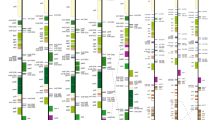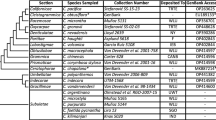Abstract
The sieve-element plastids of 126 species of theArales were investigated by transmission electron microscopy. With the exception ofPistia (with S-type plastids) all contained the monocotyledon specific subtype-P2 plastids characterized by cuneate protein crystals. While the species studied from bothAcoraceae andLemnaceae have form-P2c plastids (i.e., with cuneate crystals only), those of theAraceae belong to either form P2c (14 species), P2cs (the great majority) or P2cfs (Monstera deliciosa, only, with form-P2cs plastids in the otherMonstera species studied). The form-P2cs plastids of theAraceae are grouped into different categories according to the quantity and quality of their protein and starch contents. The subfamilyLasioideae is redefined to comprise all aroid P2c-taxa and those P2cs-genera that contain only one or very few starch grains. Only little starch is also recorded in the sieve-element plastids ofGymnostachys (Gymnostachydoideae), with the other plastid data denying a close relationship toAcorus. While equal amounts of starch and protein are generally present in sieve-element plastids of the subfamiliesPothoideae, Monsteroideae, Colocasioideae, Philodendroideae, andAroideae, maximum starch content and only very few protein crystals are found in form-P2cs plastids ofCalla (Calloideae),Ariopsis (Aroideae), andRemusatia (Colocasioideae?). In the latter, both morphology and size of sieve-element plastids are close to those ofPistia.—In theAraceae the diameters of the sieve-element plastids exhibit a great size range, but are consistent within a species and within a defined part of the plant body. Comparative data are mainly available for stem and petiole sieve-element plastids.—The accumulated data are used to suggest an affiliation of the species to subfamilies and to discuss the phylogeny of theArales. Forms and sizes of their plastids support a separation of bothAcoraceae andLemnaceae from theAraceae. The presence of S-type plastids inPistia does not favour direct and close relationships to the form-P2c genusLemna.—The prevailing form-P2cs plastids might support proposals that place theArales (together with also form-P2cs plastid containingDioscoreales) in the neighbourhood of basal dicotyledons. BesidesAsarum andSaruma (Aristolochiaceae), with monocotyledonous form-P2c plastids,Pistia (with dicotyledonous S-type plastids) gives another example for a link between the two angiosperm classes.
Similar content being viewed by others
References
Aroideana, 1978–1993: Volumes 1–13. — South Miami: International Aroid Society, Inc.
Behnke, H.-D., 1969: Die Siebröhren-Plastiden der Monocotyledonen. Vergleichende Untersuchungen über Feinbau und Verbreitung eines charakteristischen Plastidentyps. — Planta84: 174–184.
—, 1971: Zum Feinbau der Siebröhren-Plastiden vonAristolochia undAsarum (Aristolochiaceae). — Planta97: 62–69.
—, 1981: Siebelement-Plastiden, Phloem-Protein und Evolution der Blütenpflanzen: II. Monokotyledonen. — Ber. Deutsch. Bot. Ges.94: 647–662.
—, 1988: Sieve-element plastids, phloem protein and evolution of flowering plants: III.Magnoliidae. — Taxon37: 699–732.
—, 1991: Distribution and evolution of forms and types of sieve-element plastids in the dicotyledons. — Aliso13: 167–182.
—, 1994a: Sieve-element plastids: their significance for the evolution and systematics of the order. — InBehnke, H.-D., Mabry, T. J., (Eds):Caryophyllales. Evolution and systematics, pp. 87–121. — Berlin etc.: Springer.
—, 1994b: Sieve-element plastids, nuclear crystals and phloem proteins in theZingiberales. — Bot. Acta107: 3–11.
Bharathan, G., Zimmer, E. A., 1993: Phylogenetic relationships of basal monocots—rDNA sequence data. — Amer. J. Bot.80 (6, Suppl.): 133.
Bogner, J., 1987: Morphological variations in aroids. — Aroideana10: 4–16.
—, 1991: A revised classification ofAraceae with dichotomous keys. — Willdenowia21: 35–50.
Burger, W. C., 1977: ThePiperales and the monocots. Alternate hypothesis for the origin of monocotyledonous flowers. — Bot. Rev.43: 345–393.
Buscaloni, L., Lanza, D., 1937: Le basi morfologiche, anatomiche e teratologiche della nuova famiglia dellePistiaceae (Buscaloni eLanza) rappresentata dai due generiPistia edAmbrosinia. — Malpighia34: 103–180.
Buzgó, M., 1994: Inflorescence development ofPistia stratiotes (Araceae). — Bot. Jahrb. Syst.115: 557–570.
Croat, T. B., 1990: A comparison of aroid classification systems. — Aroideana13: 44–63.
Cronquist, A., 1981: An integrated system of classification of flowering plants. — New York: Columbia University Press.
—, 1988: The evolution and classification of flowering plants. 2nd edn. — Bronx: New York Botanical Garden.
Dahlgren, R. M. T., Clifford, H. T., 1982: The monocotyledons: a comparative study. — London: Academic Press.
—, 1983: Monocotyledon evolution. Characters and phylogenetic estimation. — Evol. Biol.16: 255–395.
—, 1985: The families of the monocotyledons. — Berlin: Springer.
Duvall, M. R., Learn, Jr., G. H., Eguiarte, L. E., Clegg, M. T., 1992: A problematic genus is identified as the most basal extant lineage of monocotyledons by phylogenetic analysis of DNA sequences from the plastid locus, rbcL. — Amer. J. Bot.79 (6, Suppl.): 142.
—,Learn, G. H., Jr., 1993a: Phylogenetic hypotheses for the monocotyledons constructed from rbcL sequence data. — Ann. Missouri Bot. Gard.80: 607–619.
—, 1993b: Phylogenetic analysis of rbcL sequences identifiesAcorus calamus as the primal extant monocotyledon. — Proc. Natl. Acad. Sci. USA90: 4641–4644.
Engler, A., 1920:Araceae pars generalis et index familiae generalis. — InEngler, A., (Ed.): Das PflanzenreichIV, 23A: 1–71. — Leipzig: Engelmann.
Fox, M. G., French, J. C., 1988: Systematic occurrence of sterols in latex ofAraceae: subfamilyColocasioideae. — Amer. J. Bot.75: 132–137.
French, J. C., 1985a: Patterns of endothecial wall thickenings inAraceae: subfamiliesPothoideae andMonsteroideae. — Amer. J. Bot.72: 472–486.
—, 1985b: Patterns of endothecial wall thickenings inAraceae: subfamiliesCalloideae, Lasioideae, andPhilodendroideae. — Bot. Gaz.146: 521–533.
—, 1986a: Patterns of stamen vasculature in theAraceae. — Amer. J. Bot.73: 434–449.
—, 1986b: Patterns of endothecial wall thickenings inAraceae: subfamiliesColocasioideae, Aroideae, andPistioideae. — Bot. Gaz.147: 166–179.
—, 1987a: Systematic occurrence of a sclerotic hypodermis in roots ofAraceae. — Amer. J. Bot.74: 891–903.
—, 1987b: Structure of ovular and placental trichomes inAraceae. — Bot. Gaz.148: 198–208.
—, 1987c: Systematic survey of resin canals in roots ofAraceae. — Bot. Gaz.148: 360–371.
—, 1988: Systematic occurrence of anastomosing laticifers inAraceae. — Bot. Gaz.149: 71–81.
—, 1992: Chloroplast DNA evolution and the systematics ofAraceae. — Amer. J. Bot.79 (6, Suppl.): 143.
—, —, —, 1995: Chloroplast DNA phylogeny of theAriflorae. — InRudall, P. J., Cribb, P. J., Cutler, D. F., Humphries, C. J., (Eds): Monocotyledons: classification and evolution. — Kew: Royal Bot. Gardens. (In press.)
—, 1989: Molecular systematics ofAraceae: AreAcorus andGymnostachys aroids? — Amer. J. Bot.76 (6, Suppl.): 242.
—, 1981a: Vascular patterns in stems ofAraceae: subfamiliesCalloideae andLasioideae. — Bot. Gaz.142: 366–381.
—, —, 1981b: Vascular patterns in stems ofAraceae: subfamilyPothoideae. — Amer. J. Bot.68: 713–729.
—, —, 1981c: Vascular patterns in stems ofAraceae: subfamilyMonsteroideae. — Amer. J. Bot.68: 1115–1129.
—, —, 1981d: Vascular patterns in stems ofAraceae: subfamilyPhilodendroideae. — Bot. Gaz.142: 550–563.
—, —, 1983: Vascular patterns in stems ofAraceae: subfamiliesColocasioideae, Aroideae, andPistioideae. — Amer. J. Bot.70: 756–771.
—, —, 1984: Patterns of stem vasculature inPhilodendron. — Amer. J. Bot.71: 1432–1443.
Grayum, M. H., 1986: Classification and evolution of theAraceae. — Amer. J. Bot.73: 744.
—, 1987: A summary of evidence and arguments supporting the removal ofAcorus from theAraceae. — Taxon36: 723–729.
—, 1990: Evolution and phylogeny of theAraceae. — Ann. Missouri Bot. Gard.77: 628–697.
—, 1991: Systematic embryology of theAraceae. — Bot. Rev.57: 167–203.
—, 1992: Comparative external pollen ultrastructure of theAraceae and putatively related taxa. — Monogr. Syst. Bot. Missouri Bot. Gard.43: 1–167.
Hegnauer, R., 1987: Phytochemistry and chemotaxonomy of theAraceae. — Aroideana10: 17–19.
Huber, H., 1991: Angiospermen. Leitfaden durch die Ordnungen und Familien der Bedecktsamer. — Stuttgart, New York: Fischer.
Karnovsky, M. J., 1965: A formaldehyde-glutaraldehyde fixation of high osmolality for use in electron microscopy. — J. Cell Biol.27: 137A-138A.
Kubitzki, K., Rohwer, J. G., Bittrich, V., (Eds.), 1993: The families and genera of vascular plants. 2: Flowering plants. Dicotyledons. — Berlin, Heidelberg, New York: Springer.
Mabberley, D. J., 1987: The plant book. A portable dictionary of the higher plants. — Cambridge: University Press.
Mayo, S. J., Bogner, J., Boyce, P. C., 1995: What are theArales? — InRudall, P. J., Cribb, P. J., Cutler, D. F., Humphries, C. J., (Eds): Monocotyledons: classification and evolution. — Kew: Royal Bot. Gardens. (In press.)
- - -Murata, J., Yokoyama, J., 1993: A new cladistic classification of theAraceae. — Unpubl. data, presented at “Monocotyledons, an international Conference”, Kew 1993.
Melaragno, J. E., Walsh, M. A., 1976: Ultrastructural features of developing sieve elements inLemma minor L. — The protoplast. — Amer. J. Bot.63: 1145–1157.
Missouri Botanical Garden, 1991: TheAraceae. Research at the Missouri Botanical Garden. — St. Louis: MBG, (a poster).
Petersen, G., 1989: Cytology and systematics of theAraceae. — Nordic J. Bot.9: 119–166.
Ray, T. S., 1987a: Leaf types in theAraceae. — Amer. J. Bot.74: 1359–1372.
—, 1987b: Diversity of shoot organisation in theAraceae. — Amer. J. Bot.74: 1373–1387.
—, 1988: Survey of shoot organization in theAraceae. — Amer. J. Bot.75: 56–84.
Seubert, E., 1993: Die Samen der Araceen. Die Samenmerkmale der Araceen und ihre Bedeutung für die Gliederung der Familie. — Königstein: Koeltz.
Takhtajan, A., 1969: Flowering plants. Origin and dispersal. — Edinburgh: Oliver & Boyd.
—, 1980: Outline of the classification of flowering plants (Magnoliophyta). — Bot. Rev.46: 225–359.
—, 1987: Systema Magnoliophytorum. — Leningrad: Nauka (in Russian).
Uhlarz, H., 1986: Zum Problem des „blattlosen Sprosses“: Morphologie und Anatomie der Infloreszenz vonPinellia tripartita (Blume)Schott (Araceae, Aroideae). — Beitr. Biol. Pflanzen61: 241–282.
Walker, J. W., 1986: Classification and evolution of the monocotyledons. — Amer. J. Bot.73: 746.
Author information
Authors and Affiliations
Rights and permissions
About this article
Cite this article
Behnke, H.D. P-type sieve-element plastids and the systematics of theArales (sensuCronquist 1988)—with S-type plastids inPistia . Pl Syst Evol 195, 87–119 (1995). https://doi.org/10.1007/BF00982318
Received:
Accepted:
Issue Date:
DOI: https://doi.org/10.1007/BF00982318




